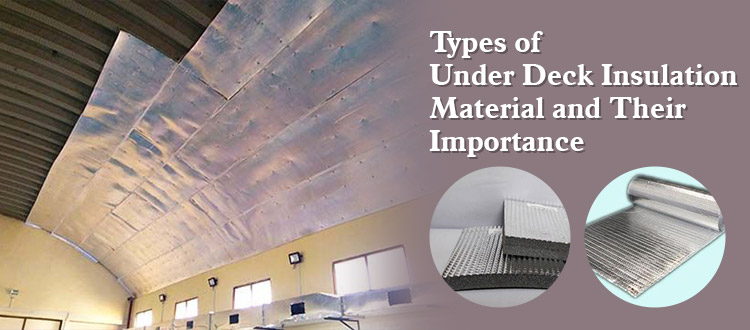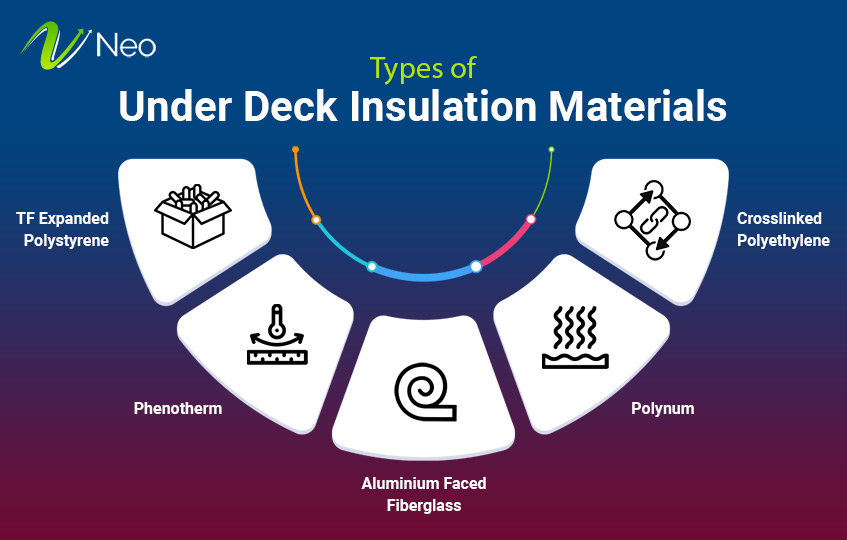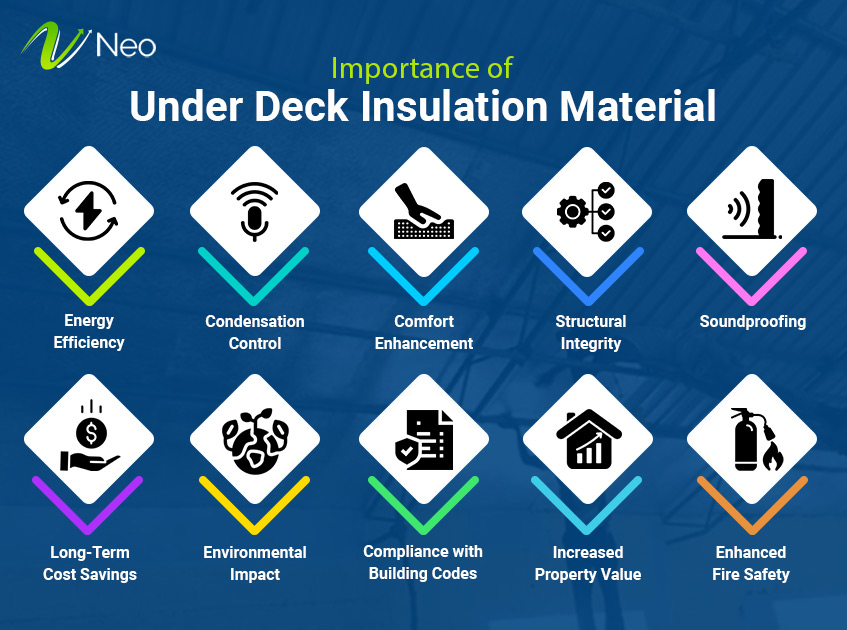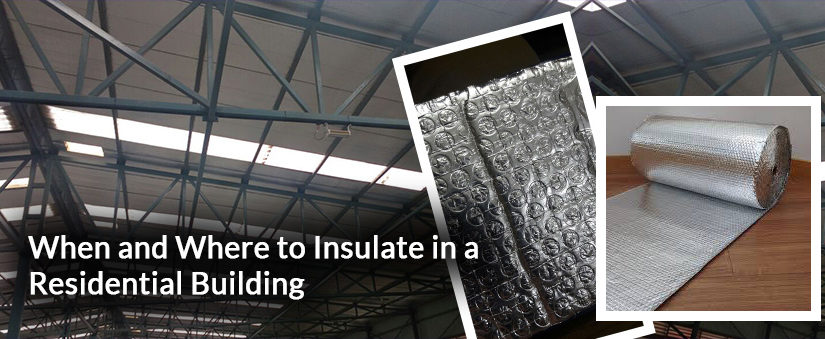One of the essential methods to reduce the inflow of heat. It is a way of reducing heat in an industrial plant, and it is also one of the critical factors to consider before constructing a building. It carries great value, and it comes with many benefits. Furthermore, there are various types of under deck insulation materials that you can put to use for your place. So, here are the advantages, importance, and the different types of underdeck roof insulation materials, put together.
Underdeck insulation refers to the installation of insulating materials beneath the flooring or decking of a structure. This insulation serves various purposes, including temperature regulation, moisture control, and soundproofing. Placing types of insulation materials beneath the deck helps maintain a consistent indoor temperature, reducing energy consumption, and preventing condensation-related issues. The insulation also acts as a barrier against sound transmission, contributing to a quieter and more comfortable living or working environment. Overall, underdeck insulation is a practical solution for enhancing energy efficiency, structural integrity, and the overall performance of a building.
Types of Under Deck Insulation Materials
There are different types of under deck insulation materials. All of them have various applications, so let’s take a look at some of them.
1. TF Expanded Polystyrene
Most people widely use it for underdeck roofs. It provides high thermal insulation. The lower the conductivity (thermal), the better the insulation, and the conductivity value decreases with density and thickness. Most people prefer using EPS because of its ability to repel water and prevent the growth of bacteria.
It doesn’t absorb water because it has a low water absorption rate. After all, the pores of EPS are very close to each other. Because of the compact porous structure, even the humid air cannot pass through, thus, preventing humidity. Other than that, it is light, easy to install, flexible, fireproof, and resistant to cold and heat.
2. Phenotherm
Not only can you use it for under deck insulation, but you can also use it for over deck, and even pipe insulation. The foam on it is versatile and has a broad utility field. It has various advantages apart from these. Furthermore, it resists fire so well that it has the highest fire rating standards. It has a low water absorption rate because of its structure.
Not only that, but phenotherm also reduces condensation and its composition makes it transmit significantly less water vapor. A plus point of using this material is that it is rodent and insect-proof. It also prevents the growth of fungi and bacteria, to a certain extent.
3. Aluminium Faced Fiberglass
It is a very effective alternative to many other under deck insulation materials that are high in cost. Most people prefer it because it is lightweight and has excellent strength. Furthermore, fiberglass is also resistant to corrosion, making it the perfect material for under deck roof. Because of its low weight, it becomes effortless to work with it. Additionally, fiberglass has the same amount of strength as steel, although it only has a quarter of the density if we compare it with steel. Most factories choose this material because it is resistant to aggressive chemicals.
Read Also: Wall Insulation: Materials, Types & Benefits Complete Guide
4. Polynum
It is one of the most suitable under deck insulation materials for commercial, agricultural, industrial, and residential roofs. It is also known to reflect around 95% of the radiant heat, and it is very safe to handle and install. There is no need to wear gloves or any such equipment for installation because there are no risks. Polynum provides energy efficiency to a high level without imposing any environmental hazards. Furthermore, it is waterproof. It does not retain moisture, and it prevents the growth of bacteria and fungi.
5. Crosslinked Polyethylene
The crosslinking turns it into a thermoset by adding a catalyst to the resin. After the process, it has a higher density, and it is the bond that makes the molecules linked to each other. It is scratch-resistant, it has better tensile strength and overall better temperature properties. Furthermore, crosslinking also increases the chemical stability, making it a perfect underdeck insulation materials.
Schedule Your Underdeck Insulation Installation Today.
Importance of Under deck Insulation Materials
First, underdeck insulation makes sure that the consumption of energy spent in maintaining the inner atmosphere is low. Not only that, but it also prevents the heat from entering the building. If the heat penetrates the premises, it significantly increases the temperature. It is essential for a factory because the roof is responsible for 40-50% of the heat gain.
1. Energy Efficiency
Under deck insulation materials help in maintaining a consistent temperature within the living or working space, reducing the need for excessive heating or cooling. This, in turn, leads to energy savings and lower utility bills.
2. Condensation Control
Insulation materials under the deck prevent condensation from forming on the underside of the deck. This is crucial in preventing moisture-related issues such as mold, mildew, and wood rot.
3. Comfort Enhancement
Proper home insulation contributes to a more comfortable indoor environment by minimizing temperature fluctuations. It helps in creating a cozy and pleasant space for occupants, whether it’s a residential or commercial setting.
4. Structural Integrity
Insulation materials act as a protective barrier, shielding the deck and the underlying structure from extreme temperature variations. This protection helps in preserving the structural integrity of the building over time.
5. Soundproofing
Under deck insulation can also serve as a sound barrier, reducing the transmission of sound from outside and between different levels of a building. This is particularly important in residential areas or spaces where noise control is a priority.
Also Read : How to Keep Home Cool in Summer?
6. Long-Term Cost Savings
While there is an initial cost associated with installing underdeck insulation, the long-term savings in energy bills and potential maintenance costs can outweigh the upfront investment. It is a cost-effective solution in the grander scheme of building maintenance.
7. Environmental Impact
By reducing the energy consumption of a building, under deck insulation materials contributes to lower greenhouse gas emissions. This aligns with environmental sustainability goals and helps in creating more eco-friendly structures.
8. Compliance with Building Codes
Many building codes and regulations require the installation of insulation to meet specific thermal performance standards. Using appropriate under deck insulation material ensures compliance with these codes, avoiding potential legal or regulatory issues.
9. Increased Property Value
Well-insulated properties are often more attractive to buyers and tenants. Investing in under deck insulation can enhance the overall value of a property, making it a wise investment for homeowners and real estate developers.
10. Enhanced Fire Safety
Some insulation materials come with fire-resistant properties, providing an additional layer of safety in the event of a fire. This can be a critical factor in regions prone to wildfires or in buildings with specific safety requirements.
Advantages of Under Deck Insulation Materials
Below are a few of the various advantages of underdeck insulation:
- Increases inner comfort and decreases the environmental effect
- Resists against vapor and moisture
- Increases cooling efficiency inside
- Roof insulation has soundproofing benefits because it reduces the noise level
- Increases cooling time and energy consumption
- Protects the building from heat
Apart from these advantages, under deck insulation materials offer better climatic conditions, and it is best for the summer season. It also has a better impact on the carbon footprint and the greenhouse effect.
Features of Under Deck Roof Insulation
- Easy to install and maintain
- Resistant to heat, and fire retardant
- Lightweight and strong
- Has a long life
Conclusion
Choosing the perfect Under deck Insulation materials is not an easy task. It requires much selecting, thinking, and considering all parameters. Then you can choose the material that suits perfectly for your purpose. So, these were the advantages and importance of under deck insulation with various materials. If you have a project requiring under-deck roof insulation then Neo Thermal Insulation is considered to provide top-quality and durable under deck insulation materials and insulation service. We have a team of devoted professionals who are ready to assist you every step of the way.
Frequently Asked Questions
1. What is the best material to put under a deck?
The best material to put under a deck is typically a moisture-resistant and durable option like marine-grade plywood, rubberized membrane, or specialized under-deck systems designed for water drainage.
2. What is the thickness of underdeck insulation?
The thickness of underdeck insulation varies depending on the material and its intended purpose. Generally, it ranges from 2 to 6 inches to provide effective thermal and moisture control.
3. What insulation is used under the floor?
Common insulation materials used under the floor include fiberglass, foam board, and spray foam insulation. The choice depends on factors like budget, desired insulation properties, and local building codes.




